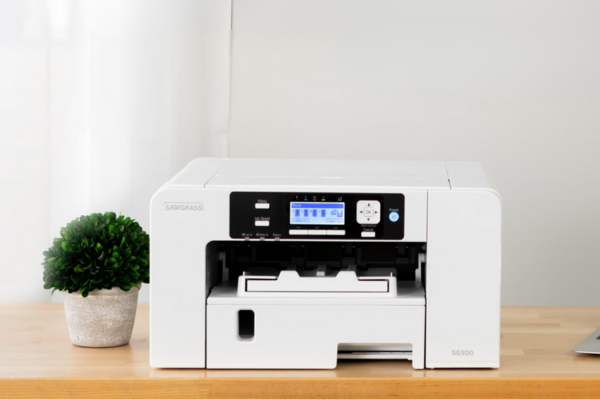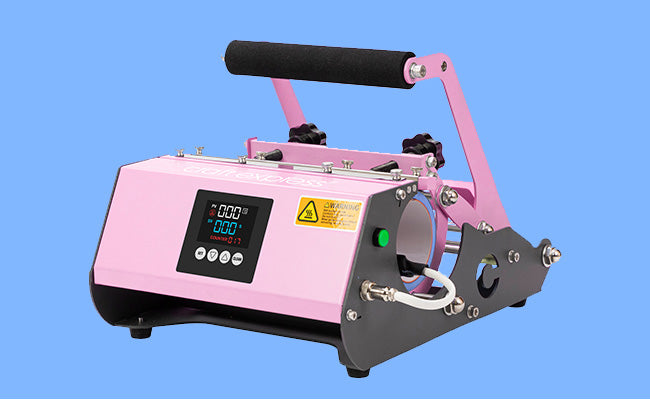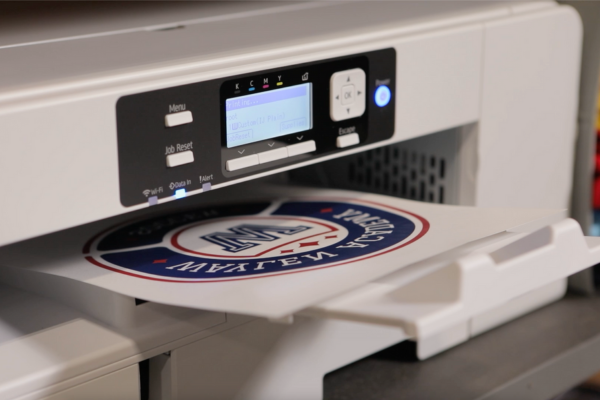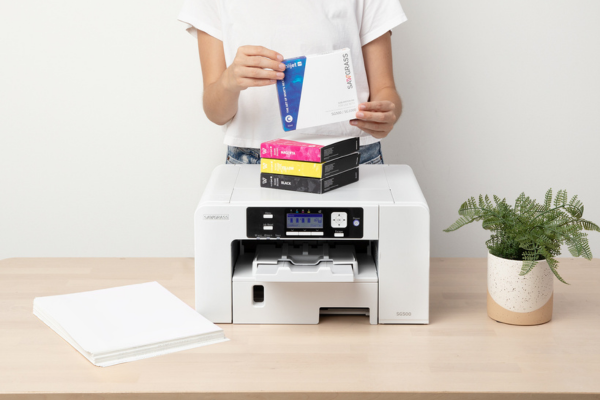
What is the difference between a regular printer and a sublimation printer?
A regular home or office printer is made to put dye or pigment ink on paper. A sublimation printer is made to print special sublimation ink onto transfer paper that you press with heat onto polyester or a polymer coated blank. The regular printer is for documents and photos on paper. The sublimation printer is for custom mugs, tumblers, shirts, and gifts where the color becomes part of the surface. If you want to print on paper, use a regular printer. If you want permanent full color designs on polyester and coated hard goods, use a sublimation printer with a heat press and the right blanks.
Key differences between a regular printer and a sublimation printer
|
Area |
Regular printer |
Sublimation printer |
What it means for you |
|---|---|---|---|
|
Ink chemistry |
Dye or pigment ink sits on paper |
Sublimation dye turns to gas under heat and bonds to polyester or a polymer coating |
Sublimation gives a smooth, permanent finish on the right blanks |
|
Media |
Paper, labels, photo paper |
Sublimation paper for transfer, then polyester fabric or polymer coated hard goods |
You need blanks that say sublimation ready |
|
Color on dark items |
Can print black and white and color on dark paper |
Works best on white or light surfaces and does not print white |
Plan art for light blanks or choose another method for black cotton |
|
Feel on fabric |
Can feel like paper if you transfer it |
Feels like the fabric itself since dye lives in the fibers |
Soft, breathable results on polyester |
|
Durability on non paper items |
Not designed for washing or wear |
Image will not crack or peel on polyester and coated items |
Great for mugs, tumblers, coasters, and shirts |
|
Extra tools |
None for basic printing |
Requires a heat press and heat safe tape plus protective paper |
Plan for a press sized to your projects |
How each printer works
Regular printer
A regular inkjet lays tiny droplets of dye or pigment onto paper. The coating on the paper holds the ink in place as it dries. This is perfect for homework, forms, photos, and labels.
Sublimation printer
A sublimation printer uses sublimation dye on sublimation paper. After printing, you place the print face down on a polyester shirt or a polymer coated blank and press with heat and light to medium pressure. The dye turns to gas, moves into the surface, and sets inside as it cools. The print becomes part of the material.
What you need for each
To print with a regular printer
-
Printer with standard dye or pigment inks
-
Paper or photo paper that fits your task
-
Optional laminator or frames for display
To print with a sublimation printer
-
A dedicated sublimation printer with sublimation ink
-
Sublimation paper that matches your printer and inks
-
A heat press that fits your blank, for example a flat press for shirts or a mug or tumbler press for drinkware
-
Heat resistant tape and protective paper
-
Sublimation ready blanks made of polyester or coated for sublimation
Always follow the instructions for your specific paper, blanks, and press. Time, temperature, and pressure can vary by item.
When to choose each one
Choose a regular printer if you need
-
Documents, school work, or shipping labels
-
Photo prints for albums and frames
-
Everyday home or office tasks on paper
Choose a sublimation printer if you want
-
Custom mugs, tumblers, water bottles, and coasters
-
Team or event shirts on white or light polyester
-
Photo panels and metal or hardboard gifts with a glossy, durable finish
-
One offs and small batches with fast turnaroun
Can I convert a regular printer to sublimation
Some inkjet printers can be set up with sublimation ink if you dedicate the machine to that purpose from day one. Once sublimation ink goes into a printer, you should use it only for sublimation. For the smoothest path, many beginners prefer a purpose built sublimation model that arrives ready for sublimation ink and paper. Either way, keep one printer for paper and a separate one for sublimation so the inks never mix.
Cost and upkeep at a glance
Regular printer costs
-
Lower entry cost for the printer
-
Ongoing cost for standard inks and paper
-
Simple upkeep like nozzle checks and alignment
Sublimation printer costs
-
Printer plus a heat press and blanks
-
Ongoing cost for sublimation ink and sublimation paper
-
Routine test prints to keep ink flowing and notes on press settings for repeatable color
If you plan to sell custom items or make many gifts through the year, the added tools for sublimation can pay off in the creative control they give you.
Tips for the best results with sublimation
-
Start with white or very light blanks for true color
-
Use higher polyester content for brighter shirts
-
Tape your transfer so it cannot shift during pressing
-
Pre press fabric for a few seconds to reduce moisture
-
Change protective paper for every press to avoid stray marks
Quick decision guide
-
You only need to print on paper. Use a regular printer.
-
You want permanent color on mugs and shirts. Use a sublimation printer and a heat press.
-
You want bold prints on black cotton. Try a different method such as DTF for that job.
-
You like a soft vintage look on blends. Sublimation on a light poly blend can work nicely.
FAQ
Can I use my regular printer with sublimation paper
No. Regular ink will not sublimate. You need sublimation ink in a dedicated printer.
Do sublimation printers also print on plain paper
They are made for sublimation. While you can print test pages, their purpose is to make transfers for polyester and polymer coated blanks.
What else do I need besides the printer
You need sublimation paper, a heat press, heat resistant tape, protective paper, and blanks that are polyester or polymer coated.
Can sublimation print on cotton
Not with standard sublimation alone. For cotton, choose another method or a blend with high polyester if you want to stay with sublimation.
Will the color last
On polyester and coated hard goods, the image is inside the surface, so it holds up very well with normal use and washing. Avoid long exposure to strong sunlight to reduce fading outdoors.
Internal Links
Closing
Both printers are great at what they are designed to do. Use a regular printer for everyday paper tasks. Use a sublimation printer when you want bright permanent designs on polyester and coated blanks. If you are ready to try, pick a simple white polyester tee or a sublimation mug, print a small test, and press with care. Then build from there with the tools that fit your favorite projects.




Leave a comment
This site is protected by hCaptcha and the hCaptcha Privacy Policy and Terms of Service apply.